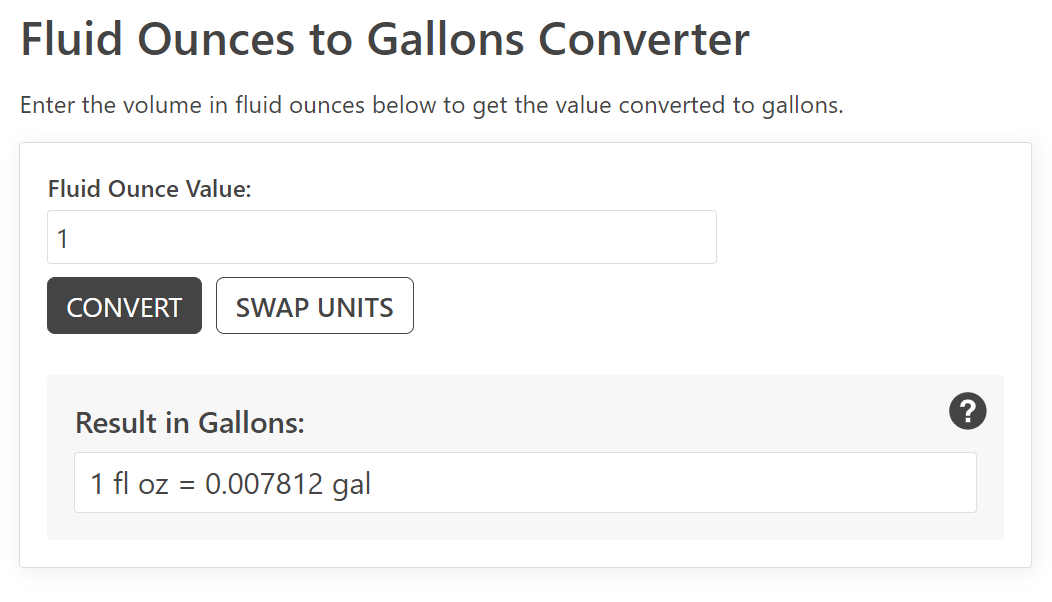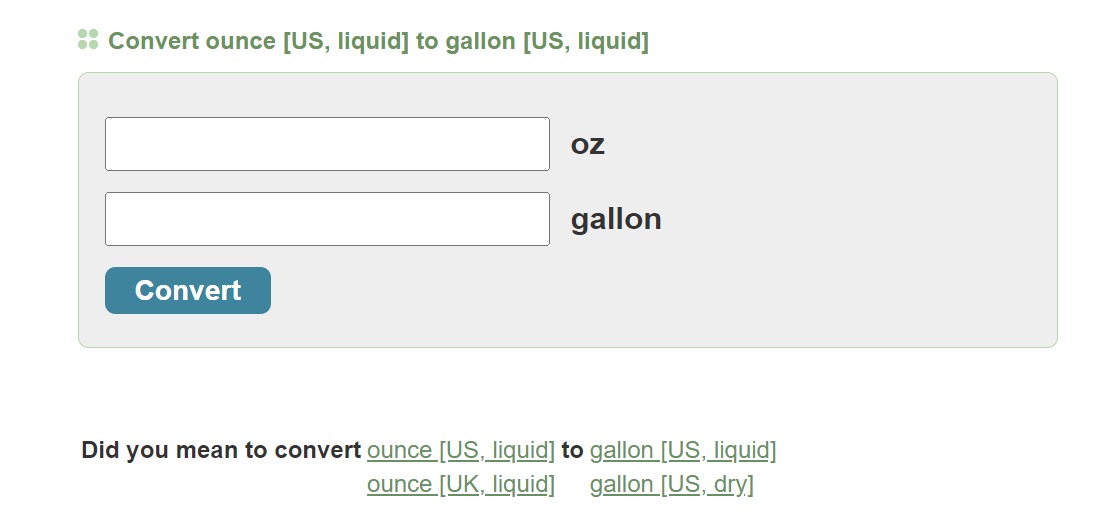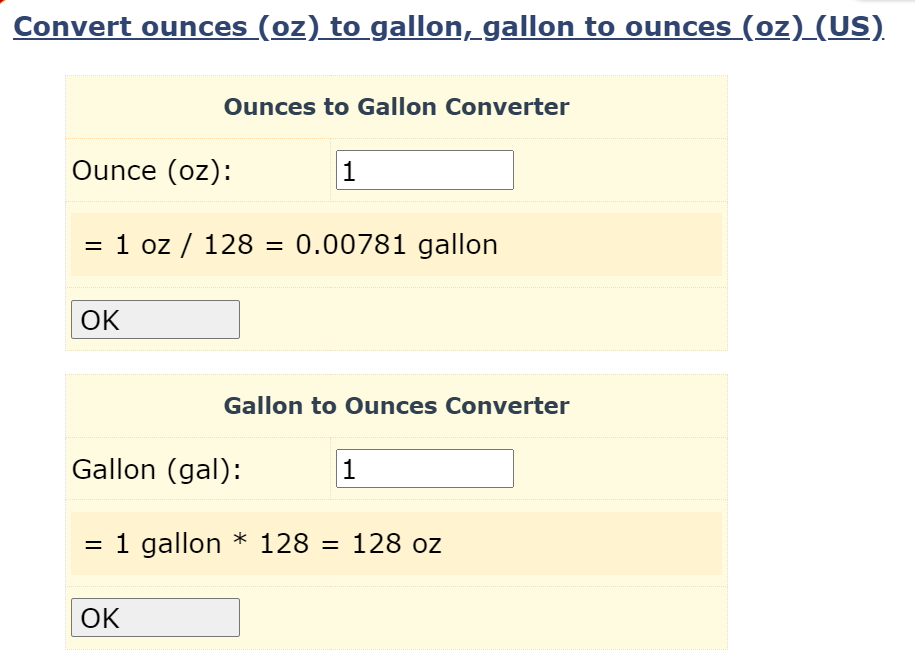How Many Ounces In A Gallon? [OZ to Gallon Conversion + Free Chart]
How many Ounces in a gallon? In the US Customary System, there are 128 fluid ounces in 1 gallon. If you’re using the Imperial System, 1 imperial gallon is approximately 160 imperial fluid ounces. This math problem often arises when dealing with measurements in cooking, chemistry, or general conversions.
It‘s crucial to understand the relationship between ounces and gallons accurate measurements, whether in the US Customary System, the Imperial System, or the Metric System.
In this article, we will explore how many ounces oz are in a gallon, provide oz to gallon conversion methods, and present helpful charts, free PDF and online converter for easier calculations.
![How Many Ounces In A Gallon? [OZ to Gallon Conversion + Chart]](https://wp-more.wukongedu.net/blog/wp-content/uploads/2025/10/image-1.png)
How Many Ounces In a Gallon?
In the US Customary System, there are 128 fluid ounces in 1 gallon. If you’re using the Imperial System, 1 imperial gallon is approximately 160 imperial fluid ounces.
Before diving into the conversion process, let’s clarify what ounces and gallons are. An ounce (oz) is a unit of volume commonly used in the United States. There are two types of ounces and gallons, A gallon is a larger unit of volume used to measure liquids and is often used in recipes and fluid measurements.
| fluid ounces (fl oz) and wet gallons | measure liquid volume |
| Dry ounces and dry gallons | measure weight |

How many fluid ounces in a gallon?
In this article, we mainly talk about the fluid measurement. In the US Customary System, one gallon equals 128 fluid ounces. In the British Imperial System, the conversion differs slightly with one imperial gallon equal to approximately 160 imperial fluid ounces. Additionally, the Metric System uses liters, where one gallon is roughly 3.785 liters.

Then why there the number of ounces in 1 gallon varies depending on the volume measurement, to find out the reason, we should break it down into the difference of the three measurement systems first.
US Customary System
The US Customary System is a system of measurement commonly used in the United States for everyday activities, including cooking, construction, and other practical applications. The units include inches, feet, yards, gallons, quarts, pints, and fluid ounces.
| Volume Measurement | 1 gallon = 128 fluid ounce (fl oz). |
| Weight Measurement | 1 pound = 16 ounces. |
| Measurement | Uses Fahrenheit for temperature. |
Imperial System
The Imperial System is a system of measurement used primarily in the United Kingdom and some Commonwealth countries. It has different values compared to the US Customary System. The units are inches, feet, miles, imperial gallons, quarts, pints, and fluid ounces.
| Volume Measurement | 1 imperial gallon = 160 imperial fluid ounce. |
| Weight Measurement | 1 pound = 16 ounces (similar to US). |
| Measurement | Uses Fahrenheit, but Celsius is also common in scientific contexts. |
Metric System
The Metric System is an international decimal-based system of measurement that is used globally, especially in scientific contexts. The units include such as meters (length), liters (volume), and grams (mass).
| Volume Measurement | 1 liter = approximately 33.814 fluid ounce (US). |
| Weight Measurement | 1 kilogram = 1000 grams. |
| Measurement | Uses Celsius for temperature. |
How to Convert OZ to Gallon?
How many ounces in a gallon? The answer, as established, is 128 fluid ounces in a gallon. To assist with conversions, we provide a chart below that outlines various ounce measurements in relation to gallons. This chart is particularly useful for those measuring liquids, as it clarifies how many ounces correspond to a gallon.
How to Convert Fluid Ounces to Gallons
To convert a measurement in fluid ounces to a measurement in gallons, you should divide the volume by the following conversion ratio: 128 fluid ounces/gallon. Here are simple steps for you.

Step 1. Confirm the Conversion Formula:

Step 2. Perform the Calculation:
For example, here’s how to convert 800 fluid ounces to gallons using the formula above.

Ounce to Gallon Conversion Chart
Here’s a useful conversion chart that shows the relationship between fluid ounces (fl oz) and gallons (gal) in the US Customary System. This chart is useful for cooking, baking, and other applications where precise volume measurements are required.
Gallon to Ounce Conversion Chart – Download free PDF
Here’s a handy conversion chart that shows the relationship between gallons and fluid ounces (fl oz). This chart is based on the US Customary System where 1 gallon is equal to 128 fluid ounces. If you need conversions for the imperial system, remember that 1 imperial gallon is approximately 160 imperial fluid ounces. This information is especially useful when converting gallons for recipes or liquid measurements.
| Gallons (US) | Ounces (US) | Ounces (Imperial (UK) ) |
| 0.0078125 gal | 1 fl oz | 1.25 fl oz |
| 0.015625 gal | 2 fl oz | 2.5 fl oz |
| 0.03125 gal | 4 fl oz | 5 fl oz |
| 0.0625 gal | 8 fl oz | 10 fl oz |
| 0.125 gal | 16 fl oz | 20 fl oz |
| 0.25 gal | 32 fl oz | 40 fl oz |
| 0.5 gal | 64 fl oz | 80 fl oz |
| 0.75 gal | 96 fl oz | 120 fl oz |
| 1 gal | 128 fl oz | 160 fl oz |
| 2 gal | 256 fl oz | 320 fl oz |
| 3 gal | 384 fl oz | 480 fl oz |
| 4 gal | 512 fl oz | 640 fl oz |
| 5 gal | 640 fl oz | 800 fl oz |
| 6 gal | 768 fl oz | 960 fl oz |
| 7 gal | 896 fl oz | 1120 fl oz |
| 8 gal | 1024 fl oz | 1280 fl oz |
| 9 gal | 1152 fl oz | 1440 fl oz |
| 10 gal | 1280 fl oz | 1600 fl oz |
| 20 gal | 2560 fl oz | 2100 fl oz |
Ounce to Gallon Conversion Chart – Download free PDF
| Fluid Ounces (US) | Gallons (US) | Gallons (Imperial (UK) ) |
| 1 fl oz | 0.00781 gal | 0.000219969 gal |
| 2 fl oz | 0.01563 gal | 0.000439938 gal |
| 3 fl oz | 0.02344 gal | 0.000659907 gal |
| 4 fl oz | 0.03125 gal | 0.000879876 gal |
| 5 fl oz | 0.03906 gal | 0.001099845 gal |
| 6 fl oz | 0.04688 gal | 0.001319814 gal |
| 7 fl oz | 0.05469 gal | 0.001539783 gal |
| 8 fl oz | 0.0625 gal | 0.001759752 gal |
| 9 fl oz | 0.07031 gal | 0.001979721 gal |
| 10 fl oz | 0.07813 gal | 0.002199690 gal |
| 20 fl oz | 0.15625 gal | 0.004399380 gal |
| 30 fl oz | 0.23438 gal | 0.006599070 gal |
| 40 fl oz | 0.3125 gal | 0.008798760 gal |
| 50 fl oz | 0.39063 gal | 0.011998450 gal |
| 60 fl oz | 0.46875 gal | 0.015198140 gal |
| 70 fl oz | 0.54688 gal | 0.018397830 gal |
| 80 fl oz | 0.625 gal | 0.021597520 gal |
| 90 fl oz | 0.70313 gal | 0.024797210 gal |
| 100 fl oz | 0.78125 gal | 0.027996900 gal |
| 200 fl oz | 1.5625 gal | 0.055993800 gal |
| 300 fl oz | 2.34375 gal | 0.083990700 gal |
| 400 fl oz | 3.125 gal | 0.111987600 gal |
| 500 fl oz | 3.90625 gal | 0.139984500 gal |
| 600 fl oz | 4.6875 gal | 0.167981400 gal |
| 700 fl oz | 5.46875 gal | 0.195978300 gal |
| 800 fl oz | 6.25 gal | 0.223975200 gal |
| 900 fl oz | 7.03125 gal | 0.251972100 gal |
| 1000 fl oz | 7.8125 gal | 0.279969000 gal |
Free Online OZ to Gallon Converter
You can easily convert the fluid ounces to gallons using various online math problem solvers. These converters simplify the process of converting oz to gallon, making it accessible for anyone needing quick answers. Whether you’re trying to figure out how many ounces are in a gallon or looking to convert gallons to ounces, these tools can help.
For instance, if you want to know how many ounces in a gallon of water or milk, you can use these converters to quickly find that 1 gallon equals 128 fluid ounces in the US Customary System. Additionally, if you’re working with imperial gallons, these converters can also help you determine the equivalent in imperial fluid ounces, ensuring you get accurate measurements for your needs.
Ounces to Gallons Converter
URL: https://www.inchcalculator.com/convert/fluid-ounce-to-gallon/
This tool allows you to convert the fluid ounces to gallons with a simple input of your desired fluid ounce amount. Visit Inch Calculator for this conversion.

Convert oz to gallon – Conversion of Measurement Units
URL: https://www.convertunits.com/from/oz/to/gallon
This versatile converter helps you switch between different volume measurements. You can find it at ConvertUnits.

Convert ounces (oz) to gallon, gallon to ounces (oz) (US)
URL: https://mainfacts.com/convert-ounces-to-gallon

How Many Ounces in a Half Gallon?
As shown in the following, 1 gallon equals 128 fluid ounces in US Customary System. However, a half gallon is a common measurement used in cooking, beverages, and other applications. Understanding how many oz are in a half gallon is essential for accurate measurements, especially when following recipes or portioning liquids. To find out how many ounces are in a half gallon, divide the total ounces in a gallon by 2, here is the process of calculation.
Step 1: Use the Calculation Formula:
To find out how many ounces are in a half gallon, divide the total ounces in a gallon by 2:

Step 2. Perform the Calculation:
There are 64 ounces in a half gallon.
![How Many Ounces In A Gallon? [OZ to Gallon Conversion + Free Chart] - WuKong Blog](https://wp-more.wukongedu.net/blog/wp-content/uploads/2025/10/image-11.png)
FAQ on How Many OZ in a Gallon
Q 1: What’s the liquid and gallon?
What’s a Liquid?
A liquid is one of the three main states of matter, characterized by its ability to flow and take the shape of its container while maintaining a constant volume. Liquid volumes are commonly measured in units such as liters, milliliters, fluid ounces, pints, quarts, and gallons (wet gallons).
What is a Gallon?
A gallon is a unit of volume measurement used primarily in the United States and the United Kingdom. It can refer to different types of gallons depending on the context:
| Liquid Gallon (Wet Gallon): | Used for measuring the volume of liquids. In the US Customary System, it is defined as 128 fluid ounces. |
| Dry Gallon | Used for measuring dry goods and substances. A dry gallon is equivalent to approximately 4.404 liters or about 148.946 fluid ounces. |
Q 2: How Many Fluid Ounces in a Gallon of Water?
When considering how many oz in a gallon of water, the answer is straightforward: there are 128 fluid ounces in a US liquid gallons. This measurement is commonly used for various liquids, including water. If you’re using the imperial gallon, which is often used in the UK, it contains approximately 160 imperial fluid ounces.

Q 3. How many fluid ounces in a gallon of milk?
There are 128 fluid ounces in a gallon of milk when using the US liquid gallons. This means that if you’re wondering how many ounces are in a gallon of milk, the answer is straightforward: 1 US gallon equals 128 fluid ounces. In contrast, an imperial gallon contains approximately 160 imperial fluid ounces.
Q 4: How many ounces are in 1/2 gallon?
1/2 gallon is equal to 64 fluid ounces. This means that when you divide the total number of fluid ounces in a gallo (128 oz) by 2, you get 64 fl oz. Thus, if someone asks how many ounces are in a half gallon, you can confidently say there are 64 fluid ounces in a 1/2 gallon.

Q 5: How many 16 oz servings are in a gallon?
There are 8 servings of 16 oz in a gallon. To find this, divide the total ounces in a gallon (128 fluid ounces) by 16 oz. So, when someone asks how many 16 fluid ounces are in a gallon, the answer is 8 servings. This can also be useful for measuring out liquids, ensuring accurate portions.

Q 6: How many 16.9 oz servings are in a gallon?
Approximately 7.57 servings of 16.9 oz can be found in a gallon. You calculate this by dividing 128 fluid ounces by 16.9 fluid ounces:
128 oz ÷ 16.9 oz ≈ 7.57 servings. This means you can fill about 7 full servings of 16.9 oz from a single US liquid gallon, with some fluid ounces left over.

Q 7: How many gallons are in 64 oz?
64 oz is equal to 0.5 gallons. You determine this by dividing 64 fluid ounces by the total ounces in a gallon (128 fluid ounces):
64 oz ÷ 128 oz = 0.5 gallons. Hence, if you need to know how many gallons are in 64 fluid ounces, the answer is half a liquid gallon.
Q 8: How many gallons are in 128 oz?
128 oz is equal to 1 gallon. This is a straightforward conversion since a gallon is defined as 128 fluid ounces:
128 oz ÷ 128 oz = 1 gallon. So, when someone asks how many gallons are in 128 fluid ounces, you can confidently say it equals 1 liquid gallon.
Q 9: How convert 32 fluid ounces to gallons?
32 fluid ounces is equal to 0.25 gallons (or 1/4 gallon). The calculation process is as below.

Q 10: What’s the difference between the liquid and dry measurements?
The distinction between liquid and dry measurements is important, especially in cooking and baking, where precision is crucial. Here’s a breakdown of the differences:
Liquid Measurements assess volume and include units like fluid ounces, cups, pints, quarts, and wet gallons. For example, A wet gallon refers to the measurement of liquid volume, which is often used for substances like water, milk, or oil. In the US Customary System, 1 liquid gallon is equal to 128 fluid ounces.
Dry Measurements assess weight and typically involve units such as dry ounces, pounds, and dry gallons. For instance, A dry gallon may refer to the measurement used for dry goods like grains or flour. Unlike liquid measurements, dry ounces (oz) are used to measure weight rather than volume, which can lead to different conversion values. For instance, 1 dry gallon is equivalent to approximately 4.404 liters, but the weight of the contents can vary significantly based on density.
Key Differences:
| Measurement Type | Liquid measurements assess volume, while dry measurements assess weight. |
| Units Used | Liquid measurements use fluid ounces and wet gallons, while dry measurements use dry ounces and dry gallons. |
| Conversion Factors | The conversion between liquid and dry measurements can differ due to varying densities of substances. For example, 1 dry ounce of flour does not occupy the same volume as 1 fluid ounce of water. |
Conclusion
How many ounces (oz) in a gallon? In summary, there are 128 fluid ounces in a gallon. Understanding this conversion is essential for accurate measurements in cooking, baking, and other applications. With the provided charts and online converters, converting oz to gallon becomes an effortless task, ensuring you have the right measurements every time. Whether you’re dealing with liquid ounces or other measurements, this guide equips you with the knowledge to navigate conversions confidently.
If your child has any questions about this calculation process, you can make an appointment for a free online trial class at WuKong Mathematics and let a professional teacher help you analyze it.
Discovering the maths whiz in every child,
that’s what we do.
Suitable for students worldwide, from grades 1 to 12.
Get started free!
My name is Kaia Bennett, and I graduated from Tianjin Foreign Studies University. With a strong background in education, parenting, economics, AI, sports, and health, I have dedicated my career to writing and sharing insights in these fields. Over the years, I have gained extensive experience as an English guest blogger, contributing to various platforms. Currently, I write for WuKong Education, where I focus on sharing learning experiences with a global audience of teenagers. My goal is to inspire and empower young minds through engaging and informative content.




![Math League: Competitions, Challenges, and Achievements [2025 Full Guide] Math League: Competitions, Challenges, and Achievements [2025 Full Guide]](https://wp-more.wukongedu.net/blog/wp-content/uploads/2024/01/school-2353406-520x293.jpg)


![What is Pinyin? Best Way To Learn Pinyin For Beginners [2025] What is Pinyin? Best Way To Learn Pinyin For Beginners [2025]](https://wp-more.wukongedu.net/blog/wp-content/uploads/2024/04/image-12-520x293.png)



Comments0
Comments